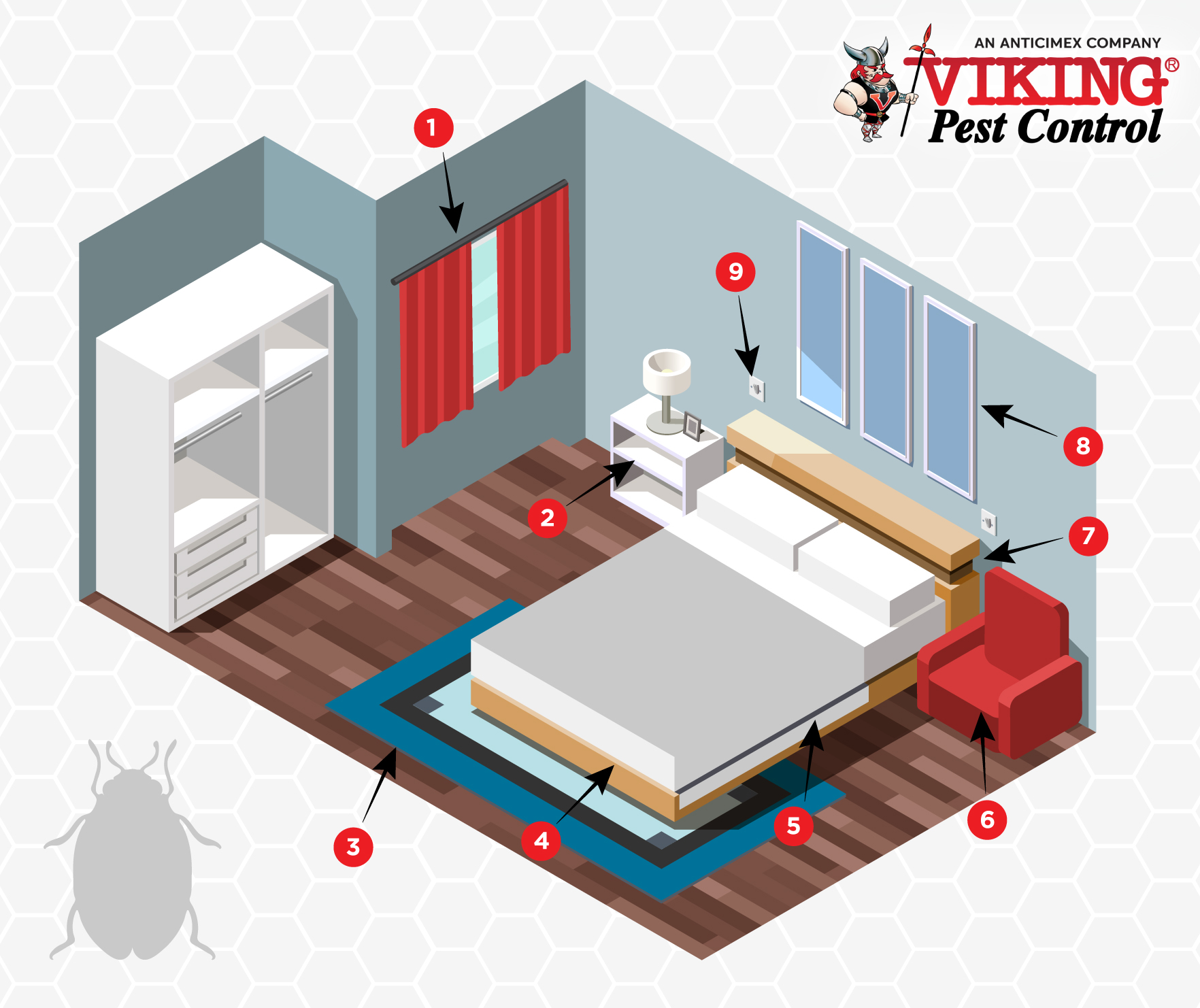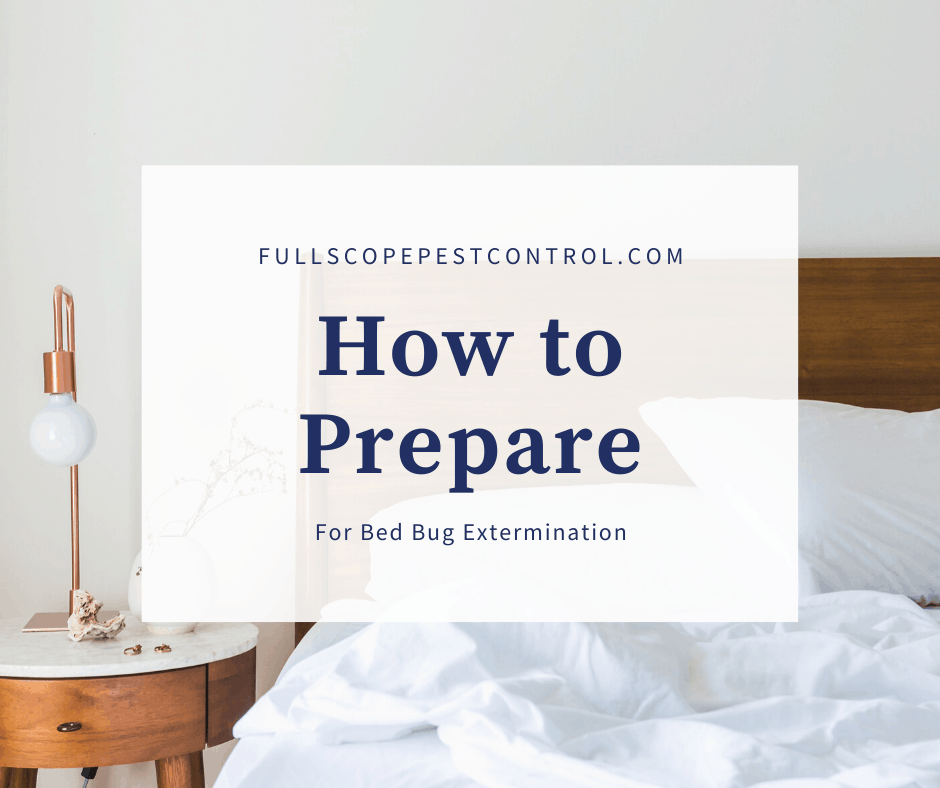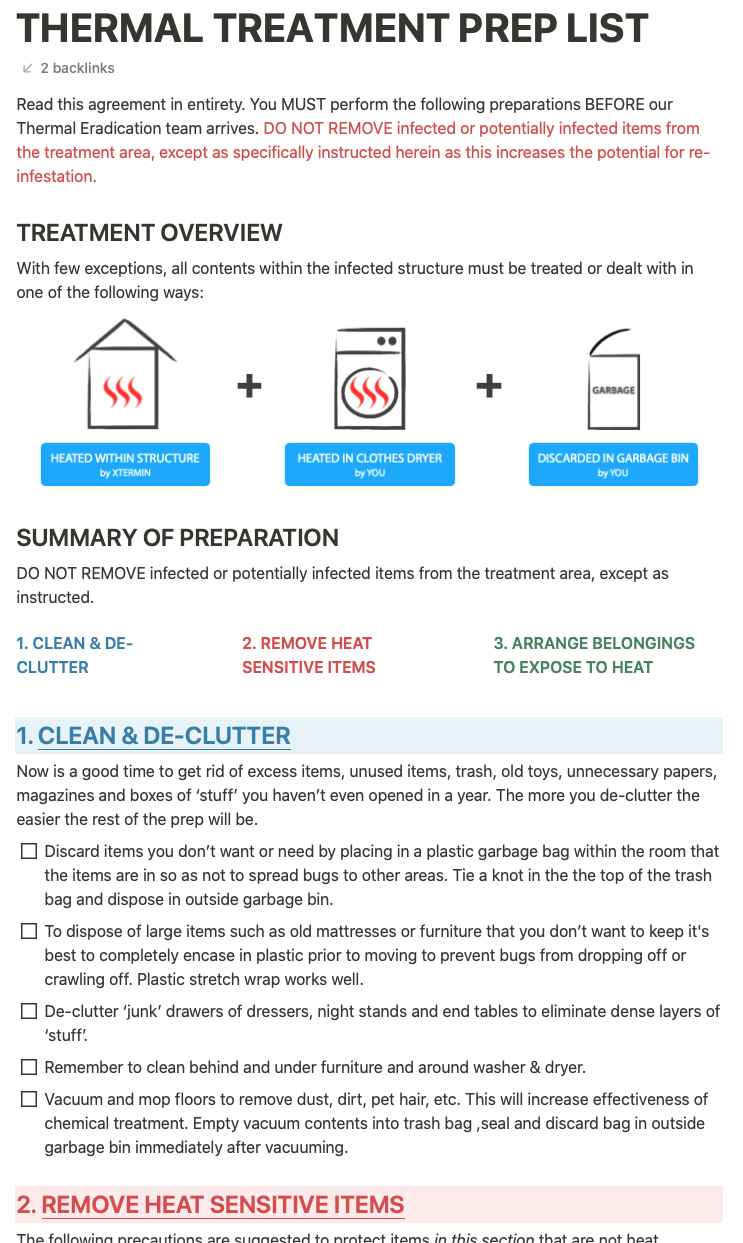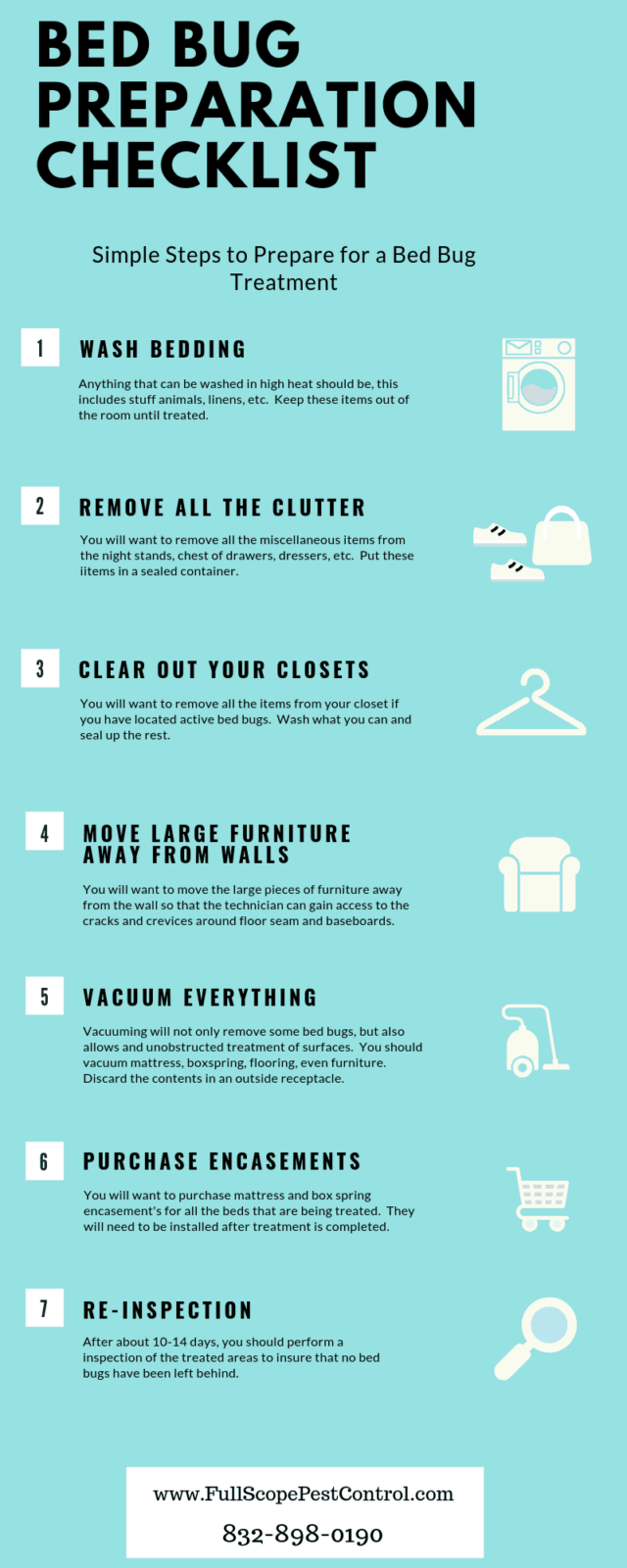To prepare for an exterminator for bed bugs, thoroughly clean and declutter your home before their arrival. Wash bedding and linens on high heat and vacuum all areas.
Dealing with a bed bug infestation can be stressful and overwhelming. However, by taking proactive steps to prepare for the exterminator’s visit, you can ensure a more successful treatment process. We will discuss effective strategies to get your home ready for bed bug extermination.
By following these tips, you can help maximize the effectiveness of the treatment and reduce the chances of reinfestation. Let’s dive into the essential steps you should take to prepare for the exterminator’s arrival and eradicate those pesky bed bugs for good.

Credit: www.vikingpest.com
Understanding Bed Bug Infestation
Dealing with a bed bug infestation can be a frustrating and overwhelming experience. These tiny pests are notorious for their ability to hide and multiply rapidly, making it difficult to eradicate them completely. However, with proper knowledge and preparation, you can take the necessary steps to ensure a successful extermination process. In this section, we will cover the key aspects related to understanding bed bug infestation, including identifying signs of bed bug infestation and understanding their behavior.
Identifying Signs Of Bed Bug Infestation
Early detection of bed bug infestation is crucial for effective treatment. Knowing how to identify the signs will help you take action promptly. Here are some common signs to look out for:
- Dark spots or stains on your mattress or bedding caused by bed bug excrement.
- Reddish or rusty stains on your sheets, pillowcases, or mattress, which could be a result of crushed bed bugs.
- Clusters of tiny, itchy red bites on your body, usually in a row or zigzag pattern.
- Presence of discarded bed bug skins or eggs near your sleeping area.
If you notice any of these signs, it’s essential to take immediate action to prevent the infestation from spreading further.
Understanding The Behavior Of Bed Bugs
Before you embark on the extermination process, it’s crucial to understand the behavior of bed bugs. This knowledge will help you develop an effective strategy to eliminate them from your home. Here are some key points to keep in mind:
- Bed bugs are nocturnal creatures, which means they are most active at night and prefer to feed on their hosts while they sleep.
- They are excellent at hiding in tiny cracks and crevices, such as mattress seams, headboards, and furniture joints.
- Bed bugs can survive for several months without feeding, making them resilient and difficult to eradicate.
- They can easily hitch a ride on your belongings, such as luggage or clothing, allowing them to spread rapidly from one location to another.
By understanding the behavior of bed bugs, you can be proactive in preventing their spread and effectively targeting their hiding spots during the extermination process.
In conclusion, understanding bed bug infestation is crucial for effective preparation and extermination. By identifying the signs of infestation and familiarizing yourself with the behavior of bed bugs, you can take the necessary steps to eliminate these pests from your home and ensure a peaceful night’s sleep.
Preparation Steps Before Exterminator Visit
When preparing for an exterminator visit to tackle bed bugs, taking the necessary steps ensures the treatment is effective. Here are crucial preparation steps to undertake before the exterminator arrives.
Decluttering And Organizing
- Remove clutter such as magazines, newspapers, and any items that can provide hiding spots for bed bugs.
- Vacuum thoroughly to pick up any stray bed bugs and their eggs.
Washing And Drying Bedding And Clothing
- Wash all bedding including sheets, pillowcases, and blankets in hot water.
- Dry on high heat to kill any bed bugs that may be present.
Ensuring your home is adequately prepared for the exterminator can maximize the efficacy of the treatment and help eliminate bed bugs efficiently.
Furniture And Belongings Treatment
Prepare furniture and belongings for effective bed bug extermination with these key steps:
Vacuuming And Steam Cleaning Furniture
1. Vacuum all furniture surfaces thoroughly to remove bed bugs and eggs.
2. Use a steam cleaner to treat fabric items and furniture for bed bugs.
Sealing And Bagging Infested Items
1. Seal infested items in plastic bags to prevent bed bugs from spreading.
2. Bag and seal clothing, linens, and soft items for washing and drying on high heat.
Cleaning And Vacuuming
Introductory Paragraph:
One crucial step in preparing for an exterminator for bed bugs is thorough cleaning and vacuuming. This step is essential in eliminating any existing bed bugs as well as their eggs and larvae. In this section, we will discuss two important aspects of cleaning and vacuuming: Thoroughly Vacuuming All Floors and Furniture and Cleaning and Disposing of Vacuum Bag.
Thoroughly Vacuuming All Floors And Furniture:
When it comes to removing bed bugs from your home, vacuuming plays a significant role. To ensure effective elimination, follow these steps:
Start with the Infested Areas: Begin by focusing on the areas that are most affected by bed bugs, such as the bedroom, couches, and chairs. Use a crevice tool attachment on your vacuum to reach into cracks and crevices where bed bugs hide.
Vacuum Thoroughly: Go over every inch of the infested area, paying particular attention to seams, tufts, and edges of mattresses, box springs, and furniture. Move slowly and deliberately to ensure thoroughness and efficiency in capturing bed bugs.
Utilize Upholstery Attachments: Make use of upholstery attachments to vacuum upholstered furniture, curtains, and carpets. Bed bugs can hide in these soft materials, so be sure to comb through them meticulously.
Empty Vacuum Bag Frequently: As you vacuum, bed bugs, their eggs, and nymphs get trapped inside the bag. To prevent reinfestation, regularly empty the contents into a sealed garbage bag and dispose of it immediately.
Cleaning And Disposing Of Vacuum Bag:
After vacuuming, it’s crucial to properly clean and dispose of the vacuum bag to prevent any potential bed bug infestations:
Seal the Bag After Use: Once you complete the vacuuming process, seal the vacuum bag within a garbage bag immediately. This will prevent any bed bugs or debris from escaping and potentially causing a reinfestation.
Dispose of the Bag Outside: Take the sealed garbage bag containing the vacuum bag and dispose of it outside of your home. This ensures that any remaining bed bugs or eggs are completely removed and will not have a chance to reenter your living space.
Sanitize the Vacuum: After disposing of the bag, sanitize the vacuum by wiping it down with a damp cloth and a mild cleaning solution. Pay close attention to areas where bed bugs may have come into contact.
Store the Vacuum Properly: Store the vacuum in a secure location where bed bugs cannot access it. Keep it away from infested areas to avoid any potential contamination or reinfestation.
By thoroughly vacuuming all floors and furniture, and properly cleaning and disposing of the vacuum bags, you will enhance the effectiveness of the extermination process and significantly reduce the chances of reinfestation by bed bugs in your home.
Cooperation With Exterminator
Cooperation with your exterminator is crucial for a successful bed bug treatment. By following their instructions and maintaining open communication, you can ensure that your home is properly prepared for the extermination process. This active collaboration will maximize the effectiveness of the treatment and help to prevent future infestations.
Following Exterminator’s Instructions
Follow the specific guidelines provided by the exterminator to prepare your home for the treatment. This may include instructions on cleaning, decluttering, and vacuuming. Adhering to these instructions ensures that the treatment can be carried out effectively, reaching all the necessary areas to eliminate the bed bugs.
Communicating About Preparations
Open and clear communication with the exterminator is essential. Discuss any concerns you have about the process or any obstacles that may be present in your home. This will allow the exterminator to provide tailored advice and ensure that no areas are overlooked during the treatment.

Credit: www.fullscopepestcontrol.com
Personal Preparation And Safety Measures
Preparing for an exterminator for bed bugs involves taking personal precautions and safety measures to ensure effective and safe treatment. This includes protecting personal items and ensuring safety during and after the treatment.
Protecting Personal Items
When preparing for bed bug extermination, it’s important to protect your personal items to prevent contamination during treatment. Here are some tips to safeguard your belongings:
- Seal all clothing and linens in plastic bags or containers to prevent bed bugs from spreading or re-infesting clean items.
- Empty and wash all clothing, bedding, and fabric items in hot water to kill any bed bugs and their eggs.
- Consider removing and sealing valuable or delicate items in protective coverings to minimize exposure to treatment chemicals.
Ensuring Safety During And After Treatment
Safety is paramount during and after bed bug extermination. It’s important to adhere to safety measures to protect yourself and others from potential hazards. Here’s what you can do:
- Follow the instructions provided by the exterminator to ensure safe handling and use of any treatment chemicals or equipment.
- Avoid re-entering the treated area until it is deemed safe by the exterminator. Proper ventilation may be necessary to clear the air of any residual chemicals.
- Wash and clean all surfaces, bedding, and clothing thoroughly after the treatment to remove any residual chemicals and ensure a safe environment.
Post-exterminator Treatment Measures
Prepare effectively for an exterminator visit for bed bugs with post-extermination treatment measures. Wash bedding in hot water, vacuum thoroughly, and declutter to ensure successful eradication of pests. Follow professional advice for a bug-free home and long-term prevention strategies.
Once the exterminator has successfully eliminated bed bugs from your home, it is important to take certain post-extermination treatment measures to ensure that any remaining bed bugs are dealt with effectively. These measures include:
Inspecting And Monitoring
Regular inspection and monitoring are crucial to ensure that the bed bugs do not make a comeback. Take the following steps to stay proactive:
- Inspect your bed, mattress, and furniture regularly for any signs of bed bug activity, such as tiny red stains, dark spots, or shed skins.
- Use bed bug interceptors or traps to catch any remaining bed bugs and monitor their presence.
- Vacuum your home frequently, paying close attention to cracks and crevices where bed bugs may hide.
- Wash and dry your bedding, curtains, and clothes at high temperatures to kill any potential bed bugs or eggs.
Preventing Future Infestations
Prevention is key to avoid another bed bug infestation. Follow these steps to minimize the chances of a recurrent problem:
- Seal any cracks or crevices in your walls, floors, or furniture where bed bugs can hide.
- Encase your mattress and box spring with bed bug-proof covers to prevent future infestations.
- Avoid bringing second-hand furniture or items into your home without thoroughly inspecting them for bed bug presence.
- Limit clutter and keep your living space tidy, as bed bugs thrive in crowded areas.
- Consider using bed bug repellents or natural remedies as an additional preventive measure.
By adhering to these post-exterminator treatment measures, you can significantly reduce the chances of a recurring bed bug infestation and enjoy a peaceful, bug-free home.
Seeking Professional Advice And Support
Consulting With Exterminator For Additional Guidance
Consulting with a professional exterminator can provide you with tailored solutions to eradicate bed bugs efficiently and prevent future infestations.
Discussing your specific situation with an exterminator allows for a thorough assessment of your home and the extent of the bed bug problem.
Exterminators can offer expert advice on preparation steps needed before treatment, such as decluttering, vacuuming, and washing bedding at high temperatures.
Connecting With Support Services If Needed
If the infestation is severe or if you require additional support, consider reaching out to support services for assistance.
- Local health departments can provide information on bed bug mitigation strategies and referrals to trusted exterminators.
- Non-profit organizations may offer financial assistance for low-income individuals dealing with bed bug infestations.
- Community outreach programs can provide resources for mental health support and coping strategies during the extermination process.

Credit: www.xtermin.com
Frequently Asked Questions On How To Prepare For Exterminator For Bed Bugs?
What Are The Signs Of A Bed Bug Infestation?
If you notice itchy welts or small bloodstains on your bedding, it could indicate a bed bug infestation. Look for small brown or red bugs in your mattress seams and furniture. If you suspect an infestation, it’s essential to act quickly.
How Can I Prepare For An Exterminator Visit?
Before the exterminator arrives, declutter and clean your home thoroughly. Remove all bedding, wash and dry it on high heat, and vacuum the entire area. Be ready to leave the premises during treatment and follow any specific instructions provided by the exterminator.
What Should I Expect During The Extermination Process?
The exterminator will likely use a combination of treatments, such as pesticides, heat, or freezing methods, to eradicate the bed bugs. It’s normal for the process to take several hours. After treatment, follow any instructions for ventilation and reentry provided by the exterminator.
Can I Prevent Future Bed Bug Infestations?
To prevent a recurrence, regularly inspect your bedding and furniture for signs of bed bugs. Avoid bringing second-hand furniture into your home without thorough inspection. Additionally, be cautious when traveling and inspect your luggage and clothing after returning from trips.
Conclusion
Preparing for an exterminator for bed bugs involves a few crucial steps. By conducting a thorough inspection, decluttering your space, washing and drying your infested belongings, and cooperating with the exterminator, you can ensure a successful elimination process. Remember to follow the recommended post-treatment measures to prevent reinfestation.
Being proactive and well-informed will go a long way in keeping your home free from bed bug infestations.
Related posts:

I’m MD Tanvir, and I bring years of expertise gained from working closely with pest control companies to the forefront. My journey in the industry has inspired me to launch Bug Battler, a platform aimed at equipping people with the know-how to combat pests autonomously. Through Bug Battler, I aim to empower individuals with practical insights to tackle pest infestations effectively.

